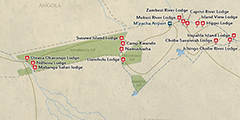
Safari Tours to Zambezi Region
-
![11-Day Amazing Northern Luxury Self Drive Safari]()
11-Day Amazing Northern Luxury Self Drive Safari
$5,600 pp (USD)
Namibia: Self-driveLuxuryLodge
You Visit: Windhoek (Start), Okonjima NR, Eastern Etosha NP, Kavango Region, Okavango River, Mudumu NP (Zambezi Region), Zambezi Region, Hosea Kutako Airport (End)

People Tours And Safari
4.8/5 – 97 Reviews
-
![12-Day Namibia, Chobe & Victoria Falls]()
12-Day Namibia, Chobe & Victoria Falls
$6,599 to $6,899 pp (USD)
Botswana, Namibia & Zimbabwe: Self-driveLuxuryLodge
You Visit: Windhoek (Start), Okonjima NR, Eastern Etosha NP, Etosha NP, Zambezi Region, Chobe NP, Victoria Falls, Victoria Falls Airport (End)

Wayfairer Travel
4.8/5 – 184 Reviews
-
![7-Day Makgadikgadi Pans, Okavango Delta & Chobe Safari]()
7-Day Makgadikgadi Pans, Okavango Delta & Chobe Safari
$6,330 to $7,940 pp (USD)
Botswana & Namibia: Private tourLuxuryLodge & Tented Bush Camp
You Visit: Maun (Start), Makgadikgadi Pans NP, Moremi GR (Okavango Delta), Zambezi Region, Chobe River, Kasane Airport (End)

Discover Africa Safaris
5.0/5 – 525 Reviews

 Namibia Parks
Namibia Parks











